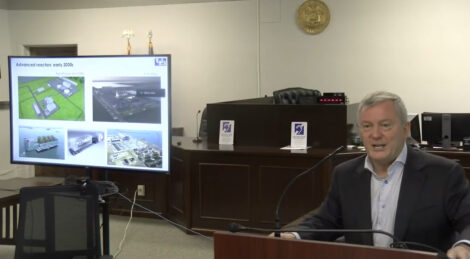State Pushes City Code Enforcement Law Changes

Crystal Surdyk, city development director, discusses changes to the city’s code enforcement law during a recent CIty Council Housing Committee meeting as councilman Brent Sheldon, R-Ward 1, looks on. P-J photo by Sara Holthouse
The city of Jamestown is set to update three sections of its code enforcement law after the New York State Department of State has recommended changes.
Specifically, the city will be updating three sections; Section Four: Building Permits, Section Nine: Unsafe Buildings, Structures and Equipment and Conditions of Imminent Danger, and Section 10: Operating Permits.
The Building Permits section updates look specifically at whether or not a local government wants to exempt certain categories of work from the building permit requirement. The state provided two alternate recommendations to this section, one outlining what categories may be exempted, and the second if the local government does not wish to exempt any category.
Section Nine: Unsafe Buildings, Structures and Equipment and Conditions of Imminent Danger, requires the local government to make reference to another local law that establishes that government’s procedures to identify and address any unsafe buildings, structures, etc. The state’s recommendations also provide two alternative options for the city to place in their law, with a few different language options for both.
And in the Operating Permits Section, the updates, similar to the Building Permits, put in required language as to whether or not the city would like to exempt from the operating permit requirement for operation of certain buildings.
During Monday’s City Council Housing Committee meeting, Crystal Surdyk, city development director, said the recommendation from the state comes in order to keep the local municipalities up to date with changes made by the state.
“They’ve updated their code so we have to update ours to be in alignment with it,” Surdyk said. “It’s not anything really substantial, just keeping up with things that have changed.”
A 20-day public comment period will be a part of the change to the law, and a public hearing will be held as well before the July voting session. Surdyk said around 2020 the city had monitoring by the state Department of State when the state created another department of oversight for code enforcement. At that time she said there were some reports from people who expressed their displeasure on how some aspects of city code enforcement were handled before 2020. She said those reports were found to be unfounded, but during that time the state had to look at everything, and the updates recommended now by the state are one of the results.
“This code had changed at the state level and it did not make it to the local level, so we just have to adopt the language,” Surdyk said. “We did find that it was in process but our prior associate corporation counsel left before it got to (City Council).”
It was noted that there is not a huge discrepancy from what the code language already said, and that the language update is more for clarification than anything. Surdyk added that this change is not anything really substantial and has already been adopted at the state level, with them adopting it being more of a formality.
“It already applies, we already follow New York State Building Codes as they are written, so we’re just making sure we are in compliance,” Surdyk said.





